Rapid Game World Creation Leveraging Geospatial Data in Game Jams: The ’Galactic Gourmet’ Post-Mortem
DOI: https://doi.org/10.1145/3697789.3697804
ICGJ '24: Proceedings of the 8th International Conference on Game Jams, Hackathons and Game Creation Events, Copenhagen, Denmark, October 2024
This paper presents "Galactic Gourmet," an innovative fusion of cooking simulation and first-person shooter (FPS) gameplay, conceived and developed during the Games Now! Game Jam - Autumn 2023. The game positions players as an intergalactic sous-chef tasked with retrieving rare and exotic ingredients from Earth to salvage a prestigious culinary competition. The game delivers an immersive open-world experience, utilizing real-world 3D geospatial data to generate high-resolution, realistic environments at runtime through 3D Tiles. Players navigate the globe in a spaceship, encountering and combating local chefs, and gathering the finest ingredients to craft extraordinary dishes. This game aims to blend the thrill of FPS mechanics with the intricacies of culinary arts. Integrating real-world geospatial data enhances authenticity and immersion, setting a new standard for realism in gaming environments. This paper details the game's development, key features, and objectives, illustrating its potential as a novel approach to rapidly creating immersive game worlds and how future game jams can benefit from this system.
ACM Reference Format:
Shamit Ahmed and Faiza Anan Noor. 2024. Rapid Game World Creation Leveraging Geospatial Data in Game Jams: The ’Galactic Gourmet’ Post-Mortem. In Proceedings of the 8th International Conference on Game Jams, Hackathons and Game Creation Events (ICGJ '24), October 11, 2024, Copenhagen, Denmark. ACM, New York, NY, USA 5 Pages. https://doi.org/10.1145/3697789.3697804
1 Introduction
The game was developed during participation in the “Games Now! Game Jam - Autumn 2023” which was an international jam running from November 7th, 2023 to November 12th, 2023. The jam was set in a hybrid mode and focused on international teams and mixing game schools. The jam was held on both "Games Now!" Discord server and at campuses of the collaborating schools.
The theme of the game jam was “Missing”, which is an intriguing concept with many possible interpretations such as missing someone, losing something, feeling absent, etc. We have always enjoyed playing cooking games, particularly those with a chaotic yet entertaining aesthetic, like Overcooked [11]. Overcooked's design principles of time management, teamwork, and dynamic kitchen environments influenced our approach to creating a similarly engaging yet challenging experience. That is why the idea of a chef missing ingredients for his recipe naturally came to our mind as an initial concept.
After that, we concentrated on developing this concept and made an effort to connect the story to one of the main gameplay elements, the utilization of geospatial data for environment generation. By having an alien protagonist to this world, it made sense to have them explore uncharted territories which also served as a fresh lens for the players to explore the game world.
With the fundamental game design and narrative firmly established, the next step involves integrating these elements with geospatial visualization technology. The objective is to develop a game that enables players to explore real-world locations and experience them as if they were physically present, akin to location-based games such as Pokémon GO [10].
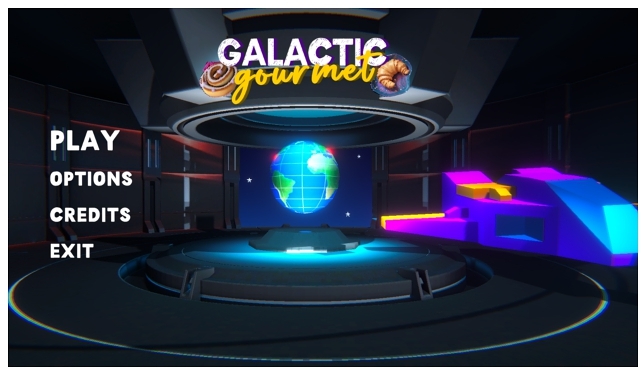
Furthermore, the concept of "Missing" as a theme aligns with narrative-driven games like Life is Strange [2], which effectively uses emotional and psychological themes to drive gameplay and player engagement. This influenced our narrative design, where the protagonist's quest for missing ingredients is interwoven with a deeper exploration of unfamiliar territories and cultures.
This paper aims to detail the development process of our game, highlighting the integration of geospatial data and narrative elements. We will discuss the significance of the game jam theme and its influence on our creative process, the methodologies employed, and the innovative aspects of our gameplay design. The remainder of this paper is structured as follows: Section 2 illustrates the game overview. Section 3 describes the methodology and tools used in the development process. Section 4 presents the user experience and player feedback. Section 5 discusses potential improvements and Section 6 briefly reflects on the project.
2 Game Overview
Galactic Gourmet is a retro first-person, single-player, non-violent shooter where the player plays as an intergalactic sous-chef on the lookout for exotic missing ingredients, who embarks on culinary expeditions to Earth in an attempt to avert the collapse of their esteemed cooking tournament. The game is developed by a two-person team.
Galactic Gourmet [1] is currently hosted at Itch.io. The game currently features 5 missions set in different locations around the world where the player has to face off against aggressive chefs who are unhappy that you are invading their homeland and stealing their precious ingredients. The game aims to introduce players to new locations around the world and explore their cuisines.
The game is centered around cooking and action-packed gameplay, two unusual themes that aren't often combined. The thematic approach to game design has led the game to its unique, fun, and humorous gameplay.
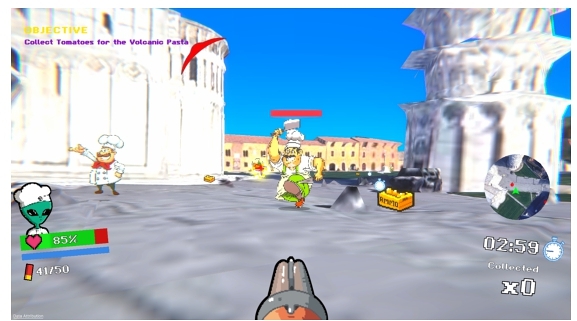
Galactic Gourmet is currently primarily targeted for the PC platform. Some of the key gameplay mechanics of the game are fast-paced movement, shooting moving enemies and avoiding projectiles, collecting ingredients, and navigating the ship through threats.
2.1 Core Game Loop
The gameplay loop is an adept tool in the beginning stages of the design process, as it shines a spotlight on the game's main mechanics and opens up the design for expansion [3].
Galactic Gourmet's core loop includes exploring the new surroundings, finding chefs, engaging in combat, collecting their ingredients, and navigating to the Galactic Cooking Station (GCS) where players can finally finish their gastronomical journey.
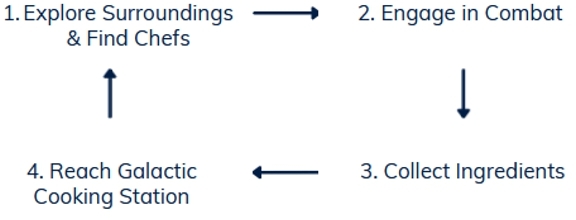
2.2 Narrative Design
Although the game's plot implementation is yet to be fully finalized, we envision it to align with the articulation provided below.
Searching for rare and absent ingredients, an intergalactic sous-chef, Spacula is coming to Earth to avert the collapse of their esteemed culinary contest. The main character travels over uncharted territories and gathers the required ingredients by following the directions of Gordon "Rocket" Spacey, the chief chef of his planet. Under Gordon's guidance, Spacula consistently outperforms in the Cooking Competition.
However, there's a chance that the higher authorities are hiding some sinister plans behind the curtains of this cooking competition. It will be much easier for the galactic chefs to establish their domination in the cosmos if they have a thorough understanding of terrestrial cuisine. There will be moments when Spacula questions the authorities and finally discovers Gordon's malign intentions. The fate of the earth might end up depending on Spacula and choosing to oppose the galactic chefs could have dire repercussions!
2.3 Innovative Level Design
The ability to creatively construct the levels is one advantage of creating the environment using pre-existing data. Level design can be further improved by adding handcrafted elements to the generated world. Instead of taking a predetermined path, players can be creative and create their own paths thanks to the environment generation. Additionally, it allows for spontaneous emergent situations that may result from a succession of actions.
3 Development Process
As mentioned earlier, the game has been developed in a game jam by a team of two. The project was developed using the Unity Game Engine version 2021.3.30f1; the C Sharp programming language was used for coding the game in Visual Studio IDE. Version control has been maintained throughout the project using Github Desktop. For generating and visualizing the 3D geospatial environment in real-time, Cesium for Unity, an open-source plugin was used. Cesium's 3D Tiling Pipeline reads and transcodes geospatial data into 3D Tiles metadata, which can then be efficiently streamed and used for visualization.
3.1 Art Direction
We intended to incorporate modern gaming mechanics with an aesthetic reminiscent of the original DOOM [5]. We experimented with 2D sprite-based props and characters in our data-generated 3D world for this reason. Billboarding was utilized to give 2D sprites a 3D appearance. It is a technique in three-dimensional computer graphics in which a sprite is rendered perpendicular to the camera without respect to camera movement meaning that the sprite will always face the camera.
Majority of the 2D pixel-art assets were made using Aesprite and others were given a pixelated look using shaders within the Unity engine. UI assets and animations were also created within Unity.
3.2 Environment Generation
Cesium services for Unity is used to create the environments found in each of the game's five levels. This is accomplished by manually adjusting the Cesium Georeference origin's latitude and longitude. Accuracy in inputting the positions ensured that the placement and orientation of the generated environment is always precise. The height is also tweaked to adjust the distance between the camera and the ground. The maximum screen space error can also be adjusted to alter the level of detail when rendering the tilesets.[6] presents several other approaches to creating virtual environments in game engines based on 3D geospatial data.
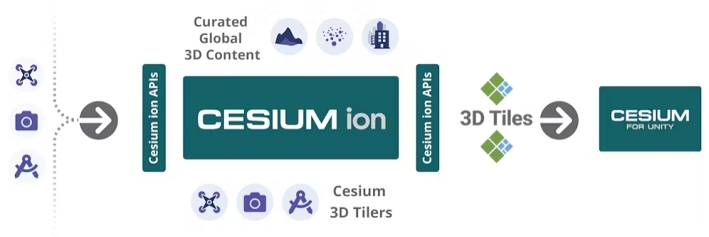
3.3 Performance Optimization
Photorealistic graphics can be achieved in the game's environment at the cost of higher render time. Ultimately, a fine balance between the resolution of the generated mesh and the loading time was needed to facilitate a smooth gameplay experience. Cesium was also utilized during the jam to create physics meshes that allowed for tileset collision. The pace of tile loading can be greatly increased by turning off the physics mesh generation, however, for this project, collisions between the gameplay elements and the surroundings were essential. Through trial and error, a level of world collision was found where the loading time was acceptable and it also helped prevent inadvertent gaps in the terrain from where players may fall through.
Cesium World Terrain fuses several data sources into a single quantized-mesh terrain tileset optimized for 3D map visualization and efficient streaming into 3D engines such as Unity. Cesium has also provided the accuracy data for this graph that represents the resolution of generated texture by regions across the globe. Here, if a region has a resolution of 30 meters, it means that each pixel in the image represents a 30 meter by 30 meter area on the ground. Therefore, objects smaller than 30 meters across may not be distinguishable.
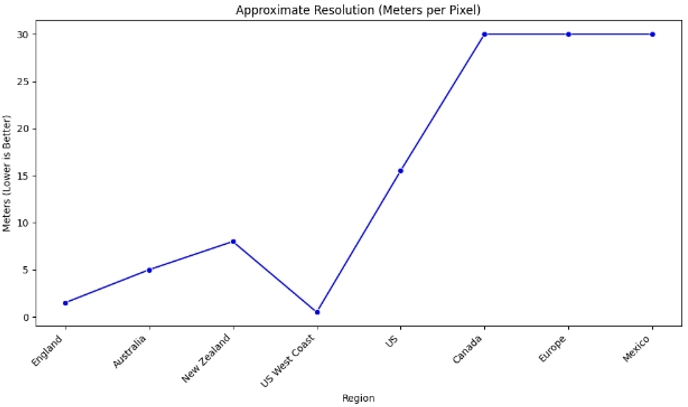
This knowledge can be used to optimize games where lower level of detail (LOD) can be achieved by adjusting the maximum screen space error. A higher value will cause a coarser visual representation of the tiles, with lower performance cost for loading and rendering.
4 User Experience and Feedback
4.1 Playtesting and Interviews
Playtesters provide the developers with an unbiased viewpoint on the game, which helps identify problematic aspects of the design. Observing testers and hearing their comments can help identify room for improvement and generate novel concepts for implementation [9].
After the game jam ended, playtesting was conducted among 5 participants [8] who were also game design students during the period. The playtest sessions were followed by semi-structured interviews exploring two primary research questions: 1. The perception of users on using geospatial data as game environment 2. How using food as a theme can enhance and develop a non-violent first-person shooter (FPS) game. Results from the interviews are as follows:
The participants provided insights based on the playthroughs and research questions. They appreciated the game's 80s sci-fi vibe, expansive world, and comedic food-related gameplay, though they noted minor frustrations with bugs and ingredient collection. They praised the use of satellite imagery for real-world immersion but highlighted its limitations and potential ethical concerns. Some participants showed appreciation towards innovation and dismissed ethical concerns about procedural generation.
Combining a food theme with FPS mechanics was considered innovative, proposing ideas such as ingredient-based ammunition. However, given the game's intention to humorously represent various cultures and their cuisines, some playtesters advised caution to avoid relying too heavily on stereotypes, which could inadvertently cause offense.
Overall, the participants found the combat flow and the overall game to be enjoyable and impressive it being a small team project made during a game jam.
4.2 Judges’ Feedback
Even though the game jam itself was not voted on or judged, the game's submission for an exhibition, later on, was judged. The game has received remarks for its unique blend of humorous and comedic vibe. The judges praised its "janky" look, praising how it accepted the unpleasant nature of the satellite-collected geographical data. Some noted that the game could become tedious due to the repetitive nature of the mission structure. The unique use of geospatial data was highlighted as a standout and appreciated feature. Overall, the game's creativity and innovative approach were recognized by the judges.
Based on playtesting and feedback from the judges, we have reiterated the game design to make the pacing feel less repetitive and added the outer space game mode where players need to navigate their way through obstacles and reach the Galactic Cooking Station (GCS) to cook their dishes with the collected ingredients and complete the level.
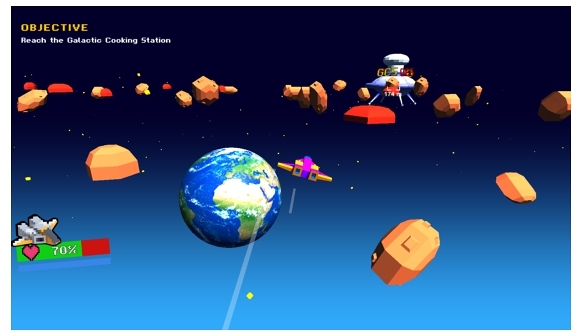
5 Potential Improvements
5.1 Preventing Ludonarrative Dissonance
It may be feasible to refine the game's overarching design to closely align with its narrative and mechanics. While the game focuses on cooking as its primary theme, this aspect is not emphasized to its full potential. Hence, when the players’ actions are inconsistent with the plot, ludonarrative dissonance may occasionally occur.
Ludonarrative dissonance can be described as having inconsistency between the story and the gameplay elements of a game. [4] uses the critically acclaimed FPS Bioshock (2K Games, 2009) as an example — throughout gameplay, the game gives the player a choice to either harvest Little Sisters to gain power or to save them. The mechanic fits the game's theme perfectly. Conversely, the narrative is designed to steer the player only on the good path, which leads to a ludonarrative dissonance, as the player's actions are fully at odds with the game's story.
5.2 Strengthening Design Pillars
The theme-first design can be solidified by unifying the design based on the cooking theme. By emphasizing on designing a cohesive world, the overall game flow and user experience can feel more natural and acceptable. Closer adherence to the theme can set certain design constraints that can eventually make the design process easier by narrowing down the design space.
The overall design and the game loop are still a work in progress as we believe the idea has a lot of potential and room for improvement, especially when we consider the usage of geospatial data for environment generation and designing a non-violent FPS game with an approach that tries to blend two unconventional genres such as shooting and cooking.
6 Reflection
Game jams are perfect opportunities to step out of one's comfort zone, challenge one's design thinking, and experiment with novel concepts or tools and we attempted to accomplish all of that with Galactic Gourmet. Testing the geospatial environment generation in a game environment in addition to the time constraint of a game jam was crucial to gauge its potential. Generating the levels or even the backgrounds is much quicker than hand-crafting them from scratch, especially in a game jam where time management is often the most significant challenge. In a team without environment artists, such as ours, this novel approach to crafting game worlds can come in especially handy.
[7] introduces a location-based serious game, CityExplorer, focused on producing and collecting geospatial data that can be used for non-gaming applications. With geospatial technology, this concept can also be used to develop novel game concepts.
One limitation of our current approach, however, is that an internet connection is required to load and render the geospatial data in real-time. Loading speed is also determined by the network bandwidth.
7 Conclusion
The development of Galactic Gourmet demonstrates the potential for integrating geospatial visualization technology into gaming, offering players a highly detailed and engaging experience. The project highlights the importance of innovative gameplay mechanics and the fusion of different genres in game jams. The insights gained emphasize the value of realistic world-building and the appeal of unique, immersive game narratives.
Usage of real-world environments can create personalized and more meaningful experiences for the players. For instance, while strolling around the grounds of their grandparents’ home and reminiscing about their early years, players can engage in an adventure-exploration game.
This paper aims to teach future game jammers and developers about this novel approach of world-building and environment creation in games by analyzing its application in our project and talking about its benefits and drawbacks. This project sets a precedent for future games leveraging real-world data to quickly design levels and craft game worlds that facilitate rapid prototyping in game jams, ultimately creating possibilities for novel mechanics, decreasing development costs, and enhancing player immersion.
References
- Noor F. Ahmed, S.2023. Galactic Gourmet. https://shamitahmed.itch.io/galacticgourmet. Retrieved June 28, 2024 from geoguessr.com
- Dontnod Entertainment. 2015. Life Is Strange. https://lifeisstrange.square-enix-games.com/en-us. Retrieved 28 June, 2024 from https://lifeisstrange.square-enix-games.com/en-us
- Emmanuel Guardiola. 2016. The Gameplay Loop: a Player Activity Model for Game Design and Analysis. In Proceedings of the 13th International Conference on Advances in Computer Entertainment Technology (Osaka, Japan) (ACE ’16). Association for Computing Machinery, New York, NY, USA, Article 23, 7 pages. https://doi.org/10.1145/3001773.3001791
- Clint Hocking. 2009. Ludonarrative dissonance in Bioshock: the problem of what the game is about. https://api.semanticscholar.org/CorpusID:141037652
- id Software. 1993. DOOM (1993). https://store.steampowered.com/app/2280/DOOM_1993/. Retrieved 29 June, 2024 from https://store.steampowered.com/app/2280/DOOM_1993/
- Julian Keil, Dennis Edler, Thomas Schmitt, and Frank Dickmann. 2021. Creating immersive virtual environments based on open geospatial data and game engines. KN-Journal of Cartography and Geographic Information 71, 1 (2021), 53–65.
- Sebastian Matyas, Christian Matyas, Christoph Schlieder, Peter Kiefer, Hiroko Mitarai, and Maiko Kamata. 2008. Designing location-based mobile games with a purpose: collecting geospatial data with CityExplorer. In Proceedings of the 2008 international conference on advances in computer entertainment technology. 244–247.
- Nuutti Nykänen Antti Kangas Néstor Feijoo Miikka Junnila, Jaakko Kemppainen. 2024. Interview on Game Mechanics. Personal interview conducted by Shamit Ahmed.
- Patrick Milvi. 2023. Taking a theme-centric approach to designing a non-violent FPS — The Fashion Police Squad post-mortem. https://aaltodoc.aalto.fi/items/089282eb-18fc-4f8f-a2c5-d548b811f13f. Retrieved 29 June, 2024 from https://aaltodoc.aalto.fi/items/089282eb-18fc-4f8f-a2c5-d548b811f13f
- Inc. Niantic. 2016. Pokémon GO. https://pokemongolive.com/?hl=en. Retrieved June 29, 2024 from https://pokemongolive.com/?hl=en
- Ghost Town. 2025. Ghost Town Games presents: Overcooked. https://ghosttowngames.com/. Retrieved June 29, 2024 from https://ghosttowngames.com/

This work is licensed under a Creative Commons Attribution International 4.0 License.
ICGJ '24, October 11, 2024, Copenhagen, Denmark
© 2024 Copyright held by the owner/author(s).
ACM ISBN 979-8-4007-1779-6/24/10.
DOI: https://doi.org/10.1145/3697789.3697804